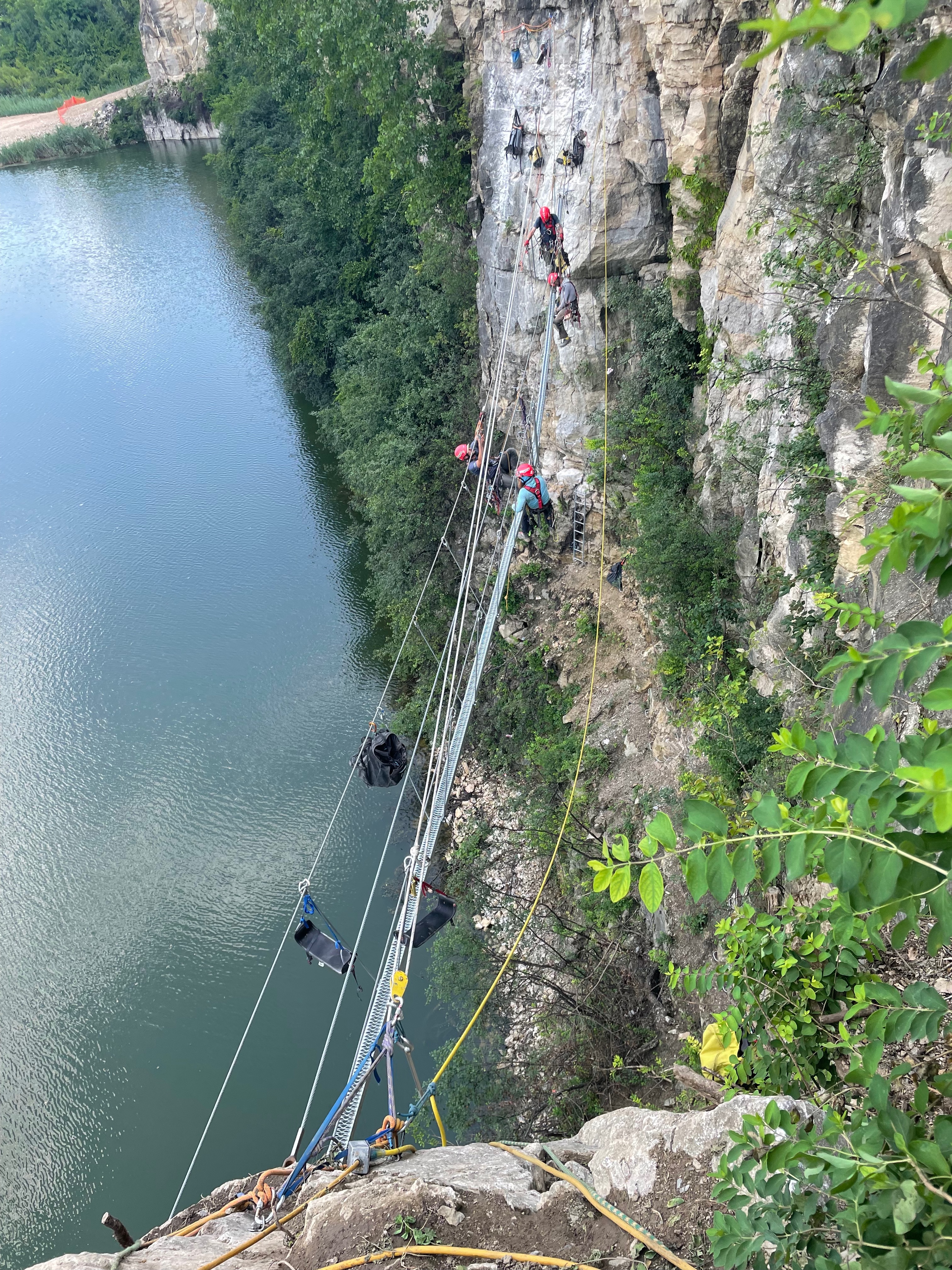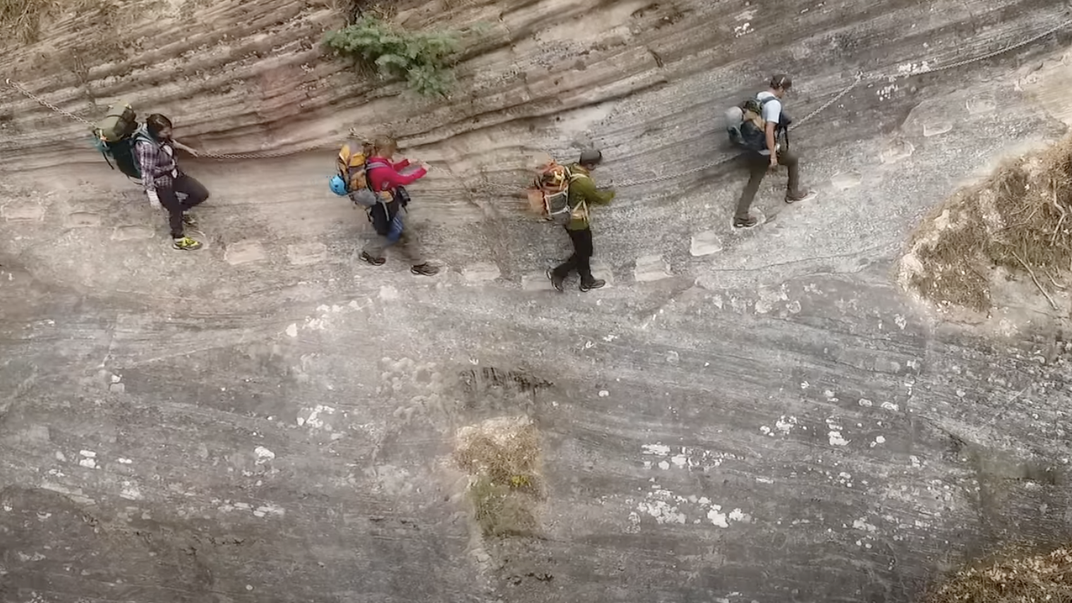Via Ferratas Are Finally Catching On in the United States
With origins in Europe, the assisted climbing routes are springing up at luxury resorts and on private land this side of the Atlantic
:focal(1000x752:1001x753)/https://tf-cmsv2-smithsonianmag-media.s3.amazonaws.com/filer_public/4f/5e/4f5e845a-be28-46ce-aeeb-9cd88586f78e/gettyimages-1257586676.jpg)
Iron rungs cling to the nearly vertical vermillion cliffs outside Zion National Park in Utah. Strapped into harnesses and helmets, climbers make their slow ascent of the meandering route that stretches 450 feet from canyon to mesa.
These outdoor enthusiasts have no mountaineering or rock climbing training, and they don’t need it. If you can climb a ladder, you can climb a via ferrata, say those championing the assisted climbing routes. Adventurers are secured to a fixed cable with ropes and carabiners, so the “iron way” isn’t dangerous, it just sometimes feels that way.
Since the 1990s, via ferratas have drawn adventure tourists who seek the thrill of mountain climbing but lack the necessary skills to scale the rock on their own. Italy has more than 400 via ferratas and Austria over 550, while Germany, Switzerland and France combined offer more than 500. But despite decades of popularity in Europe, via ferratas haven’t caught on in the United States—until now.
“What makes via ferrata climbing so popular is that it doesn’t take a lot of prior technical climbing experience in order to participate,” says Reed Rowley, partner and director of development at Via Ferrata Works, a Colorado-based based company that has designed routes throughout the U.S. “The popularity is certainly growing in the U.S. and around the world, beyond Europe.”
/https://tf-cmsv2-smithsonianmag-media.s3.amazonaws.com/filer_public/4e/57/4e57d7ea-5916-4170-b10f-97b829023647/1m2ttaba.jpeg)
The via ferrata wasn’t initially built for thrill-seekers. Its origins are far more utilitarian. In 1915, as World War I raged across Europe, Austro-Hungarian forces ferociously battled Italian ones to maintain their control over the Dolomite Mountains. Because passages through the steep, jagged and brutally cold peaks were virtually impossible to maneuver without climbing gear, troops attached ropes and wooden ladders to the cliffs, lifelines that helped them to move supplies across the vertical landscape.
Although a handful of flimsier via ferratas equipped with hand hooks, carved footholds and ropes had been built in the Alps and Dolomites between 1843 and 1903, those constructed in the so-called Mountain War remained relatively intact after the conflict ended. Three decades later, after World War II came to a close, alpine enthusiasts restored the long-abandoned climbing routes, replacing frayed ropes with steel cables and rotted wooden ladders with metal ones.
In the early days after restoration, the iron routes of the Dolomites were primarily used by skilled mountaineers. But the potential attraction that via ferratas held for the alpine curious wasn’t lost on their proponents. By the close of the 20th century, adventure tourism companies were marketing the rocky routes as an alternative to mountain climbing, an activity with all of the thrill of a cliffside ascent and none of the risk.
Despite the growing popularity of via ferratas across the Atlantic, the Wilderness Act of 1964, which banned the installation of permanent climbing anchors, made construction of iron ways difficult in the U.S. The first to sidestep the red tape were Mark and Kathy Meyer, owners of Kentucky’s Torrent Falls Climbing Adventure (now Southeast Mountain Guides), who built their via ferrata in a privately owned horseshoe-shaped canyon in the Red River Gorge in 2001. The following year, climbing enthusiast Stu Hammett followed suit, building the NRocks Via Ferrata on private land in West Virginia’s Allegheny Mountains.
By the end of the 2000s, via ferratas had begun pushing westward, with a handful of routes, including the Telluride Via Ferrata, emerging on private land in the Rocky Mountains. Since then, they’ve sprung up throughout the country’s mountainous regions, on privately owned lands and at luxury resorts like Alaska’s Alyeska Resort and Utah’s Amangiri that aren’t subject to the Wilderness Act. With both the National Park Service and Forest Service currently challenging the ban on fixed climbing anchors on public lands, they may become more common in the near future.
/https://tf-cmsv2-smithsonianmag-media.s3.amazonaws.com/filer_public/6d/5d/6d5d1876-6c90-4956-932f-03a5572808b2/53160146861_5bb4826451_k.jpg)
Each “iron way” is a little different, says Rowley. Designers can choose from a variety of elements, including steep ladders, narrow suspension bridges, welded iron rungs and cable crossings, but ultimately it’s the site’s geography that determines exactly how each route is built—and the “wow factor” that makes it unique.
“A via ferrata is essentially rock climbing. It provides all of the same sensations,” says Michele Van Hise, managing partner at Zion Adventures, a guiding service and outfitter based in Springdale, Utah. Between 2018 and 2022, the company built three via ferratas near Zion National Park, including Shorty Town, which snakes up and down across a cliff suspended over the flowing water of Oak Creek. They may seem intimidating, but the challenge is mostly a mental one. Zion Adventures has had climbers as young as 5 and as old as 74 white-knuckle their way along the routes.
Though they’re late to the game, American designers aren’t just copying European via ferrata blueprints. Last summer, the U.S. became the first country to build an iron way in a densely populated urban setting, the Quarry Trails Via Ferrata in Columbus, Ohio, designed by Rowley and Via Ferrata Works.
“The Quarry Trails Via Ferrata is novel because it takes via ferrata recreation to the people rather than the other way around,” says Rowley. “There is a real sustainability, equity and accessibility aspect to this approach. We’re continuing to think about building on this theme, perhaps even looking at integrating vias with grain silos, buildings and water towers.”
In the meantime, Via Ferrata Works is busily completing two new routes in Colorado. “There is certainly a lot of momentum, with more and more people discovering the activity,” says Rowley. “As builders, we’re always trying to outdo our last project with new ideas and more thrilling components to push the boundaries of what’s possible.”
Here are five of the most exciting via ferratas to climb in the U.S.
Eye of the Needle & Via Ferrata, Utah
The world’s only via ferrata to ascend from a slot canyon, Zion Adventures’ Eye of the Needle & Via Ferrata is a knockout. But to reach the route, climbers first must descend through a ponderosa pine forest, completing up to ten rappels against the backdrop of a perennial waterfall cascading from a hole in the sandstone. The canyon’s iron way, a series of sturdy iron bars that rise up the 450-foot cliff, guides climbers back to the mesa as views of southern Utah’s iconic red rocks unfold at their backs. It’s “a one-of-a-kind experience,” says Van Hise, “this is high adventure.”
Cloud Ladder Via Ferrata, Colorado
/https://tf-cmsv2-smithsonianmag-media.s3.amazonaws.com/filer_public/7f/d7/7fd78a6f-7355-45c5-b844-815c2ec8a686/cloud_ladder_bridges_photo_credit_owen_kent.jpeg)
Built in 2021 by Rowley’s Via Ferrata Works, the Cloud Ladder Via Ferrata is the steepest iron way in the United States—and not for the faint of heart. Spanning 600 vertical feet just outside Rocky Mountain National Park, it takes up to five intense hours to complete the route, which includes a 45-foot-long suspended rope bridge and a floating 47-foot treadway bridge.
Veilbreaker Skybridges, Alaska
Adventure-oriented Alyeska Resort opened its Veilbreaker Skybridges—two gravity-defying passageways suspended 2,500 feet above the valley floor—in summer 2023. Although the route doesn’t have all the elements of most via ferratas—no ladders to climb or rungs to monkey around on—the narrow 600-foot crossing, with its bird’s eye view of more than half a dozen hanging glaciers and the lush Chugach temperate rainforest, still requires climbing safety gear. “We wanted to add an activity that was memorable for our guests yet did not require a lot of skills, like mountain biking or steep climbing,” says Émilie Pageau-Bisson, director of brand strategy at the resort’s parent company, Pomeroy Lodging. The Skybridges “offer a degree of adventure, connection and admiration for the nature that surrounds us.”
Skyline Traverse, California
High above the Olympic Valley and the sapphire waters of nearby Lake Tahoe hangs the Skyline Traverse. The longest of four overlapping via ferrata routes in the Sierra Nevada Mountains gets progressively harder as it goes. Climbers begin at the Flamingo Buttress, where they cross a short cable bridge and ascend a low vertical wall before scrambling up a 100-foot cliff to a narrow chimney. The most exhilarating moment of the four-hour route, crossing a 50-foot monkey bridge with only a thin cable underfoot, comes right before the summit, when the panoramic views of the alpine landscape are at their best.
Quarry Trails Via Ferrata, Ohio

Planning Your Next Trip?
Explore great travel deals
Smithsonian magazine participates in affiliate link advertising programs. If you purchase an item through these links, we receive a commission.
/https://tf-cmsv2-smithsonianmag-media.s3.amazonaws.com/accounts/headshot/Shoshi_Parks_headshot.jpg)



/https://tf-cmsv2-smithsonianmag-media.s3.amazonaws.com/accounts/headshot/Shoshi_Parks_headshot.jpg)